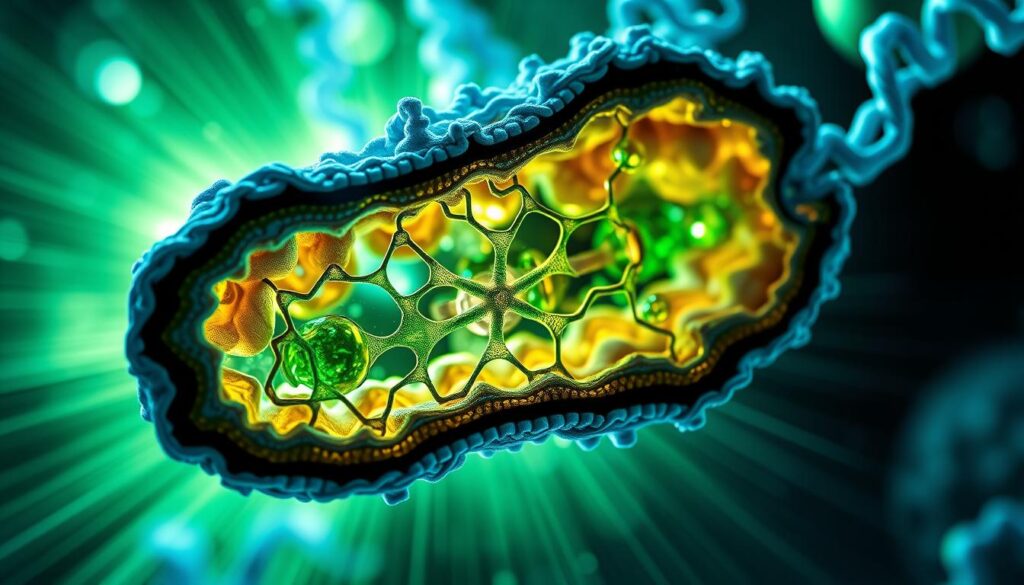Did you know nature has been using advanced physics long before humans discovered it? A groundbreaking study from Berkeley Lab shows how plants harness quantum effects to achieve near-perfect energy efficiency. This discovery reshapes our understanding of biological systems.
Led by Graham Fleming, researchers used ultra-fast spectroscopy to observe energy transfer in the FMO protein. Their findings reveal how molecules in plants maintain coherence during photosynthesis. This allows energy to flow seamlessly with almost no loss.
The implications are enormous. By studying these natural processes, scientists may develop revolutionary energy solutions. Nature’s blueprint could lead to sustainable technologies that mimic its flawless design.
Key Takeaways
- Plants use quantum physics to achieve 100% energy efficiency
- Berkeley Lab researchers observed this phenomenon using advanced spectroscopy
- The FMO protein shows remarkable quantum coherence properties
- Energy transfer in photosynthesis occurs with minimal loss
- These findings could inspire new sustainable energy technologies
Scientists Uncover Quantum Secrets in Photosynthesis
The 2007 Nature paper revealed groundbreaking insights into photosynthetic energy transfer. Co-authored by Greg Engel and Graham Fleming’s team, it showed how energy moves like a wave in the FMO protein. This defied classical “hopping” models, where energy was thought to jump between molecules.

Breakthrough Evidence of Quantum Coherence
At 77 Kelvin, researchers detected quantum beats lasting 660 femtoseconds. These oscillations proved energy explores multiple potential pathways simultaneously. Quantum coherence—a state where particles act in sync—enables this ultra-efficient process.
“The wavelike motion suggests nature exploits quantum physics for perfect energy routing.”
Why This Challenges Classical Energy Transfer Models
Classical theories assumed energy “hops” randomly between molecules. The FMO protein, however, acts as a model system showing superposition. Here, energy exists in multiple states at once, minimizing loss. This discovery reshapes how scientists view biological systems.
The implications? Clean energy tech could mimic these natural processes. By harnessing such quantum effects, we might unlock unprecedented efficiency.
How Quantum Effects Boost Energy Transfer Efficiency
Ultrafast lasers reveal how plants turn sunlight into fuel with zero waste. Unlike classical theories that describe energy hopping between molecules, nature uses a smoother, wave-based approach. This discovery reshapes our understanding of biological systems—and how we might harness their perfection.
Wavelike Motion of Excitation Energy
Picture tossing a pebble into a pond. The ripples spread outward, exploring all paths at once. Similarly, energy in photosynthesis flows through molecules like coordinated waves. This wavelike motion excitation lets plants test multiple routes simultaneously, ensuring no energy is lost to randomness.

In the FMO protein, bacteriochlorophyll molecules act like tiny antennas. They vibrate in sync, creating a quantum network that routes energy with pinpoint accuracy. At 77 Kelvin (-321°F), these effects become crystal clear—literally. Cold temperatures stabilize the system, letting scientists observe the phenomenon.
The Role of Femtosecond Spectroscopy in Observations
How do researchers capture such fleeting events? Enter femtosecond spectroscopy. By firing laser pulses lasting millionths of a billionth of a second, they map energy transfer in real time. The technique evolved from 2005 studies of the FMO protein, but 2007’s breakthrough revealed its full potential.
“Femtosecond lasers are like high-speed cameras for the atomic world—freezing motion we once thought impossible to see.”
These measurements produce 2D electronic spectra, colorful maps showing energy pathways. The data confirms what nature’s known for eons: synchronized light waves outperform random hops. For more on how data drives these discoveries, explore our privacy policy handling standards.
Cutting-Edge Tools: 2-D Electronic Spectroscopy
Scientists now have a powerful tool to map energy flow like never before. 2-D electronic spectroscopy captures ultrafast movements within molecules, revealing how nature optimizes energy transfer. Funded by the U.S. DOE and Miller Institute, this technique combines precision with innovation.

Tracking Energy Flow with Femtosecond Precision
How does it work? Three laser pulses and a local oscillator amplify signals, creating a detailed map of energy transfer processes. The method detects changes in light-induced excitation, showing pathways once invisible to science.
Graham Fleming compares it to super-heterodyne radio processing: “Just as radios decode overlapping signals, 2-D spectroscopy deciphers molecular conversations.”
Key Findings from the FMO Protein Study
The FMO protein’s seven-pigment structure made it ideal for analysis. Researchers from UC Berkeley and Washington University observed coherent oscillations, proving energy explores multiple routes simultaneously. This coherence minimizes loss—a blueprint for future tech.
| Technique | Advantage | Application |
|---|---|---|
| 2-D Spectroscopy | Tracks femtosecond-scale energy flow | Biology, nanotechnology |
| Traditional Spectroscopy | Limited temporal resolution | Basic molecular analysis |
Beyond biology, this method could revolutionize artificial photosynthesis and solar cells. By mimicking nature’s design, we might unlock energy solutions as efficient as plants.
Conclusion: Harnessing Nature’s Quantum Blueprint
Nature’s blueprint for energy efficiency might hold the key to future tech breakthroughs. Over 2.7 billion years, evolution perfected photosynthesis’ quantum design, creating molecular systems that work flawlessly.
Next, scientists will test how temperature and light variations affect these energy transfer processes. The goal? Replicate nature’s efficiency in synthetic systems.
Imagine solar panels that mimic leaves, using energy pathways to eliminate waste. As Greg Engel notes, “This gives us a new way to think about artificial photosynthesis.”
Supported by the U.S. Department of Energy and Lawrence Berkeley National Lab, this research could redefine clean energy. Nature’s secrets aren’t just fascinating—they’re a roadmap to innovation.

